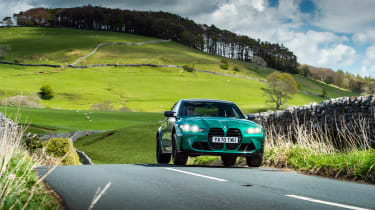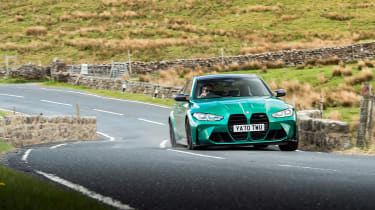BMW M3 Competition review – ride and handling
It’s a big car, and with lots of weight to manage, but feel and precision are in abundance
What’s the new M3’s biggest forward step? The fact that it no longer wants to hurl you into a ditch the first time you open the throttle on anything but a billiard table-smooth surface. You sense the improved body control within the first few miles; the ride feels more settled – though for some it will still be too harsh even in its softest setting – and more capable of absorbing the surface and being able to filter out the unnecessary noise. The springs and dampers feel more compliant and more suited to the road, softer in their actions and working in tandem with the stiffer shell that has allowed BMW M’s engineers to tune the chassis accordingly.
On a tighter road there’s great stability under braking, with just enough pitch to not be distracting, and what lean there is as you commit the nose is at a level you can work and push against rather than having to constantly manage. With more time and experience you soon find yourself asking more of the 275mm-wide front Michelins, the resistance building through the steering wheel as they bite harder. And then it’s down to how early you want to open the throttle. Too early in the first two gears will happily stir the stability systems – this M3 is still rear-wheel drive remember, although all-wheel drive will become an option later in the year – but slacken them off a notch and there’s a big enough window to allow the rear axle to generate maximum forward momentum balanced with minimal sideways slip.
It’s on quicker roads, where the surface bucks, twists and throws up a horrid camber or two, that the G80 makes the largest gains over the car it replaces. There’s so much more composure coming back at you, with a front axle that feels more determined to seek out grip and a rear that’s able to work with the surface and flow with clarity rather than try to hammer it into submission.
More reviews
Group tests
In-depth reviews
Reviews
- BMW M3 Touring 2025 review – the best fast estate gets even better
- Used BMW M3 (E46, 2000 - 2006): an analogue sports coupe icon
- BMW M3 CS Touring 2025 review – the Nürburgring’s fastest-ever estate tested
- Used BMW M3 CS (E46, 2005 - 2006) review – BMW M's forgotten modern classic
- BMW M3 (2007 - 2013, E92) review and specs for V8 coupe
- BMW M3 CS 2023 review
And all the time the new M3 Competition is serving up its most impressive trick of all: masking its bulk. If someone told you it weighed 1600kg you’d have little reason to doubt them; the fact that you can add 130kg to that figure takes some serious processing power from your cranium to compute (although nowhere near as much processing power as the car’s various electronic systems require to make it feel this way).
Perhaps the biggest compliment that can be paid to the new M3 is that while it may have proportions more suited to an M5 from a couple of generations ago, it manages to drive, steer and thrill in as close a fashion to an M2 Competition as is possible to get from a car that’s both bigger and heavier. Thirty-five years of development has that effect.
The all-wheel-drive set-up on the M3 xDrive is similar to the one used on the M5 in that it uses an electronically controlled multi-plate clutch in the transfer case, and in normal driving is largely rear-wheel drive. Only when there’s a loss of grip at the rear axle do the front driveshafts come into play, their keenness to intervene depending on whether the car is in its standard 4WD setting or in 4WD Sport, the latter setting biased towards a rear-wheel-drive handling style.
And like the M5 (but not lesser 5s, such as the M550i), you can also choose to disable the ESP system completely and then force the car into a purely rear-wheel-drive setting, too. Much of the four-wheel-drive hardware is bespoke for the M3/M4, and the xDrive also has its own front suspension tuning and geometry over the rear-drive car, plus the engine’s oil system has also been upgraded.
Of course, you can get to a point where the xDrive car does feel different, and that’s when the limit of grip is exceeded – and this is where it gets very clever. When in its normal setting the four-wheel-drive system provides the M3 with a tremendous sense of surefootedness, and an ability to deploy all 503bhp just about anywhere and at any time. In 4WD Sport mode, it will allow much more slip at the rear axle, but whereas in the rear-drive car you’d be managing that slip with the throttle, the xDrive simply hooks up after a certain point and hauls out of the corner.
It’s impressive, not just because of the outright level of performance it gives the car, but also because unlike so many other systems, it doesn’t feel particularly ‘four-wheel drive’. There’s no ‘snatch’ from the front axle as it takes up the slack, no urgent steering correction required on the exit of the corner to make sure the front wheels are pointing where they’re now powering towards. In fact, it just feels like the rear-driven chassis but with a huge dollop of additional traction.





